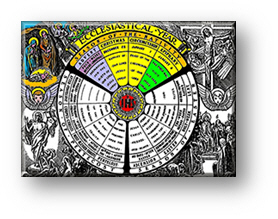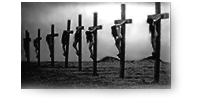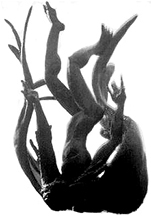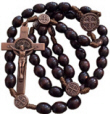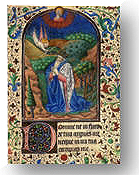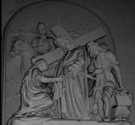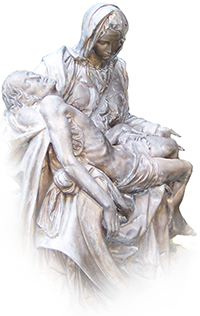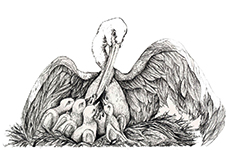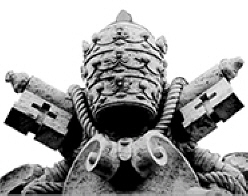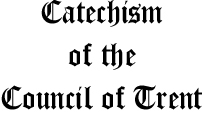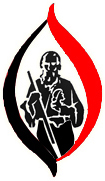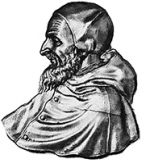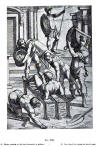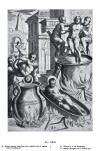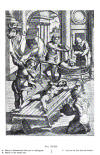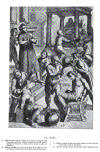|

The Tortures and Torments
of the Christian Martyrs
from
De SS. Martyrum
Cruciatibus
(a Modern Edition)
Chapter VII
Of the Brazen Bull, Frying-pan, Pot, Caldron,
Gridiron, and Bedstead; of the Chair, Helmet, and
Tunic, and other Instruments of Martyrdom of Red-Hot Iron
In
the preceding chapter we had discussed
some of the instruments of martyrdom by which condemned persons were
burned; it only remains now to discuss the other instruments
through which the same or a similar manner of torture was inflicted.
We will begin first with the Brazen Bull, one of the most
unimaginably cruel devices of punishment used among the ancients. The
Brazen Bull, or Bronze Bull, was, in essence, a specially formed container
into the which victims to be tortured were cast by an opening, or door,
that was located in its side (as we see in the Acts of the Martyr
St. Eustachius, as well as the Dialogue of Lucian, called Phalaris).
After the door was shut, a fire was lighted about the bull, causing
the victim imprisoned within it to suffer indescribable agonies, and
by their screams and cries to imitate the bellowing of a bull. What
is more evil still, this brazen device was so cunningly wrought to the
likeness of a real bull that (as Lucian attests in the Dialogue
named) movement and voice alone were lacking to persuade anyone that
it was a living animal.
The inventor of this device (as Ovid tells us in the Tristia)
was an Athenian, an extremely clever man named Perillus. Thinking he
would be doing a great favor to Phalaris, the Tyrant of Agrigentum,
as one who ever delighted in novel tortures and was accustomed to find
his chief pleasure in inflicting cruel punishments, Perillus himself
became its first victim. By the Despot’s order, from whom he was expecting
no small reward, he was thrown himself into the bull to test the working
of his own invention. And so we find that Ovid writing the following:
Et Phalaris tauro
violenti membra Perilli Torruit;
infelix imbuit auctor opus.
(“And Phalaris roasted Perillus’ limbs in the cruel bull; the
ill-starred inventor was the first victim of his own handiwork”)
and to the same end, Propertius:
Et gemere in tauro,
saeve Perille, tuo.
(“And to groan, cruel Perillus, in the bull you invented”).
To these passages we may
also add what Valerius Maximus had to say of Perillus and his cruel
device:
“Then there was that
cruel inventor of the brazen bull in which men were shut up and
fires kindled underneath, so that they were constrained by the long-drawn,
though unseen, torment to utter resounding cries, which took on
the form of mere bellowings, so that their wails of agony might
not, being expressed in human voice and language, appeal to the
pity of the Tyrant Phalaris. Now inasmuch as he was glad to rob
the miserable victims of all hope of pity, the artist was the first
to be imprisoned in the bull and deservedly to demonstrate the dreadful
effects of his own device.”
More can be read of this
in the Letters (Pseudo-letters) of Phalaris, in Cicero’s,
Against Piso, in Pliny, in Ovid’s Tristia, and especially
Lucian in the Dialogue entitled Phalaris.
But more still! Not only did Perillus become a victim of his
own contrivance, but so did Phalaris himself. For the time eventually
came when his great cruelty and violence could be tolerated no longer
and the citizens of Agrigentum seized him, shut him up in the same bull
in which he had burned others, and roasted him alive.
Ovid commemorated his fate in these lines:
Utgue ferox Phalaris,
lingua prius ense resecta,
More bovis Phario clausus in aere gemas:
(“And like cruel Phalaris, the tongue first cut out with the
sword and imprisoned in Egyptian brass, may you groan and bellow
like a bull.”)
Valerius Maximus, however,
would seem to think differently as to the mode of this Tyrant’s death,
for he writes:
“By his fierce invectives
against their cowardice, Zeno so roused the Agrigentines that they
set on Phalaris and stoned him.”
Cicero, in his, De
Officiis, appears to agree with him:
“Phalaris was renowned
above all mankind for cruelty, who perished not in an ordinary revolt,
but by a general uprising against him of the whole population of
Agrigentum.”
Nevertheless we can reconcile
the differing statements of Ovid on the one hand and of Valerius Maximus
on the other, if we suppose the Tyrant was first attacked with stones,
and afterwards cast into the red-hot brazen bull.
Some endured this
form of punishment as a result of their profession of their Christian
Faith. Indeed, so great was the rage and fury with which the Heathen
assailed Christ’s faithful servants, that they once again revived the
use of many types of excessively cruel, but antiquated, instruments
of Martyrdom. Among the Christians who were cast into the brazen bull
and there shut up within it to die were Saints Antipas, Saint Eustachius,
a Roman patrician, his wife, Theopistes, and his sons Agapius and Theopistus;
also St. Pelagia, virgin and martyr, all of whom (as their Acts
proclaim) sprang lightly and with alacrity into the red-hot monster,
and rendering fervent thanks to God; Eustachius along with wife and
sons in great joy, while Pelagia, the virgin of Tarsus, sang with great
gladness a Hymn of Triumph to God.
Furthermore, we read of still other Christian martyrs who were imprisoned
in the brazen bull — but by the Divine grace protecting them, came out
of it safely and unharmed. Among these was the soldier, St. Barbarus,
and St. Heliodorus, the latter of whom is thus commemorated under December
1:
“Anniversary of the
Blessed Martyr Heliodorus of Maghedo, a city of Pamphilia. Aurelian
being Emperor of Rome and Aetius Governor in the city of Maghedo
in Pamphilia, St. Heliodorus for preaching of Christ in that
city was brought before the Governor. When he refused to make sacrifice
to idols, he was instantly hung up and thrashed; and when he felt
the bitterness of the torment, he cried out, ’Lord Jesus Christ,
help me.’ And at once he heard a voice from Heaven saying, ’Fear
not, I am with thee.’ This voice was also heard by those who were
holding the torches already lighted to burn him — these and four
others present who saw Angels staying the torments, then themselves
believed in Christ, and for remonstrating with the Governor, were
thrown into the sea and so also received the crown of victory.
The Governor then
commanded the brazen bull to be heated and the Martyr to be cast
into it; but no sooner was this done than by his prayers, the monster
which had been red-hot, grew instantly cold. The Governor was all
the more astonished because he heard the man singing psalms inside
the brazen bull, now cold. Going to the brazen engine which, at
one moment, had been shooting out sparks, and at the next turned
suddenly cold again, he reviled the Saint, saying, ‘Wicked sinner!
Did your magic arts prevail against the fire?’ To which the holy
man made answer, ‘No! My magic arts are Christ! But give me three
days’ time to think over in my heart what I must do.’
Receiving this respite,
the Governor took him secretly to the Temple of the gods, and when
Heliodorus had made a prayer to the true God, all the idols suddenly
fell down and broke in pieces. When the Governor heard this, he
was filled with fury and ordered Heliodorus to be brought before
him and then hanged, and nails heated red-hot to be driven into
his head.
When the Judge saw
that the Martyr remained unconquered, whatever the number and diversity
of torments he endured, he sent him away to the city of Atala, where,
remaining constant in his profession of the Faith, he was set in
a hot frying-pan, where he stood and prayed, continuing all the
while unhurt.
Seeing this, all the
bystanders believed in the Lord, crying, ‘A great God verily is
the God of the Christians.’ When the Governor saw many people converted
to believe in Heliodorus’ God, and fearing that they might rescue
him from out his hands, he ordered Heliodorus to be carried back
again to Maghedo, to which the guards led him praying and singing
psalms. Then the Saint was questioned a second time, but only continued
the more steadfast in his former confession of Jesus Christ.
The Governor then
commanded his tongue to be cut out, and that he should be hung up
and scourged in the space of two hours. So after putting a collar
on him, they dragged him forth of the city. But the holy man signed
to them with his hand, and stood still to preach; and when his sermon
was ended, he was cut to pieces.”
Of
the Brazen Pot as an Instrument of Martyrdom
This is mentioned both
in Holy Scripture, in the Book of the Maccabees, and by Josephus
in his work on the same subject, as well as in the Acts of the
Saints, especially those of St. Boniface, St. Juliana, and St. Lucy.
A pot was a very large vessel made of brass, into the which condemned
persons were stripped and thrown, to be boiled or seethed within it.
The persecutors of the early Christians used many different sorts of
vessels for the torturing of offenders, particularly Christians. They
had frying-pans for lightly roasting or frying their flesh, and caldrons
and pots for thoroughly boiling or seething them. These pots were nothing
more nor less than ordinary kitchen pots for boiling meat withal, as
we find, for instance, in Varro:
“To spin wool, and
at the same time keep an eye on the pot, that the pottage be not
burned;”
And by Plautus, in his
Amphitryon:
Optimo jure infringatur
olla cineris in caput
(“He well deserves a pot of ashes be broken over his head”)
Also, Persius in his
Fourth Satire says:
Caepe et farratam,
pueris plaudentibus, ollam
(“Bring out, amid the clapping of the lads, onions and the pot of
pottage”)
These pots, then were
simply very large vessels made of brass, in which the martyrs were boiled
as a punishment at once terrible and ignominious. They were made (as
we see from very ancient artifacts often dug up from the ruins of Rome)
in the likeness of the pots we commonly use for cooking food, without
rims, but having two handles, which were part square, part round — square
from the bottom to the middle, round from the middle upwards to the
brim, or else made on the model of a pair of ears. On the other two
sides they had two partly hollow projections of iron facing one another,
in which rings, also of iron, were fitted, to enable the tormentors
to more easily lift and carry them where they would. All this will be
found more plainly and particularly shown in the pot which we have had
drawn from ancient examples to be seen in Figure XXII.
Different
Ways in Which the Servants of God were put into the Pot
Christians sometimes were
plunged into a pot head downwards; as we read in the Acts of
the Martyr St. Boniface:
“The Judge in anger
ordered a pot to be brought and filled with boiling pitch, and the
holy martyr — St. Boniface — to be cast into it head first. So the
blessed martyr of Christ, after signing the Sign of the Cross, was
plunged into the pot.”
In other cases victims
were thrown into the pot so tightly squeezed and doubled up that their
heads were made to touch their knees. This is attested to by Josephus
in the following:
“He is put by the
executioners’ hands into the pot — such is the name given to this
form of criminal punishment. The press being turned or revolved,
his holy head is forced to his knees, and his body being thus reduced
in height, the champion of the Faith was squeezed miserably into
the aforesaid pot.”
We should observe here
that by the press Josephus denoted some instrument for pressing
or squeezing — not, however, the great press or beam by which grapes
and olives are crushed and pressed, but rather a smaller device for
pressing, such as fullers, paper-makers, and printers chiefly use. Thus
Pliny remarks, in speaking of different kinds of paper,
“Then are they squeezed
in the presses and dried in the sun, and the several sheets joined
together.”
Of
the Caldron
There was yet another
sort of vessel used in antiquity (as the Histories of the Martyrs
bear witness) for the boiling of Christians: a very large brazen
caldron which was filled with boiling oil, pitch, molten lead, or wax,
into which the victims were cast. We read of this often in the Acts
of the Blessed Saints, in particular those of Saints Saba and Zerio,
and St. Veneranda, virgin and martyr. We hear of such a caldron again
in the Book of the Maccabees (Chapter VII) and in Josephus’
History of the Wars of the Maccabees. As to its shape, this appears
to omit other references, sufficiently indicated by the lines in Ovid’s
Metamorphosis:
Vina dabant animos,
et prima pocula pugna,
Missa volant, fragilesque cadi, curvique lebetes.
(“Wine stirs their spirit, and the fight begins with hurling
flying cups and fragile jars and rounded caldrons.”)
In both these vessels
were tortured great numbers of Christ’s soldiers — in pots, Saints Boniface,
Juliana, Lucy, Erasmus; and in caldrons, St. Zeno, St. Veneranda virgin
and martyr, Saints Saba, Marianus, Pantaleemon, Eulampius and his sister
Eulampia, Zenobius and Zenobia, brothers and sisters.
Of
the Frying-Pan as an Instrument of Torture
Mention is made of the
frying-pan in the Second Book of the Maccabees (Chap. VII) and in many
collections of the Acts of the Blessed Martyrs, such as those
of St. Eleutherius the Bishop, Saints Fausta and Justina, virgins and
martyrs.
The frying-pan — as the name implies and from what we find in the
Histories of the Blessed Martyrs — was a wide open dish or plate,
which (as we see in the Acts of the Martyrs) was filled with
oil, pitch, resin or sulfur, and then placed over a fire; when it began
to boil and bubble, the Christians of either sex who had persisted steadfastly
and boldly in the profession of Christ’s faith were then thrown into
it, to the end they would be roasted and fried like fishes cast into
boiling oil. So in the Hymn of St. Romanus we find Prudentius writing
as follows concerning one of the seven Maccabees brothers who was tortured
in this way:
Videbat ipsos apparatus
funerum
Praesens suorum, nec movebatur parens,
Laetata, quoties aut olivo stridula Sartago frixum torruisset puberem.
(“The mother was present, gazing on all the preparations for
her dear one’s death and showed no sign of grief, rejoicing rather
each time the pan, hissing hot above the olive wood, roasted and
scorched her child.”)
As to its shape, we believe
it to have been round since all vessels that we use for seething or
frying, or for boiling water, are circular. Nor can it really be doubted
that the vessels in use today have been modeled on the types we have
found used throughout history. One of these is to be seen to this
day in the Church of St. Laurence beyond the Walls, in which that most
gallant champion of Christ, St. Laurence, baptized a soldier of
the Emperor’s guard, by the name of Romanus.
Of
the Manner in which Martyrs were Tortured in the Frying-Pan
Christian Martyrs were
roasted in frying-pans in two different ways. Sometimes they were cast
bodily into it with faces looking heavenward. In these cases,
we must conjecture that there was some proportion between the instrument
of torture and the man tortured within it, and so we assume that victims
of this form of torture were thrown into a frying-pan which was more
an oval than one perfectly round. At other times (as we see in the
Acts of St. Euphemia) they were not set bodily into the pan,
but rather, limb by limb. This is expressly described in the account
of the holy virgin St. Euphemia, where we read:
“Priscus the Proconsul
commanded her to be divided limb from limb with knives, and the
severed members to be roasted in a frying-pan ...”
Now in this case it would
seem likely that the frying-pan was more of the round variety.
It must be further understood that the Blessed Martyrs, when roasting
in the pan, were forced down in it by means of iron forks; for the purpose
of the iron framework or gridiron and of the frying-pan seems to have
been one and the same, both of them being used for burning Christians
to death. So just as martyrs which were broiled on the gridiron were
held down on it by the executioners with iron forks (as stated in the
Acts of St. Laurence), similarly those tortured in the frying-pan
may be surely assumed to have been pushed down and held within it in
the same way.
Of
the Gridiron and the Iron Bed
Having examined the instruments
with which the Christian martyrs were boiled or fried,
we now turn our attention to those means by which their flesh was broiled
by their heathen tormentors. These were the gridiron and the
iron bed, both of which are frequently mentioned in the various
Acts of the Blessed Martyrs.
Gridirons are spoken of in the Histories of numerous Saints,
such as Saints Eleutherius, Conon and Dulas, of St. Domna virgin and
martyr, and of St. Laurence; iron beds also in the Acts
of St. Eleutherius, as also in those of the most sainted Clement of
Ancyra, Plato, and others.
As to the iron frame
or gridiron, its nature is sufficiently indicated both by the
name, its description in the Histories of the Saints, and by
the gridiron itself upon which the most Holy Confessor of Christ, St.
Laurence, was broiled, and which is religiously preserved in part at
the Church of St. Laurence in Lucina, and in part at Paneperna. It was
framed of three iron bars set lengthwise and a span distance one from
the other, of one finger thick, two broad, and of a length suitable
for its purpose, with seven or more shorter pieces of iron placed crosswise,
and likewise separated a span from each other. Of these some were round,
and some square; the square ones being the two which were joined to
the ends of the longitudinal bars to brace together and strengthen the
whole gridiron. There were likewise fixed at each corner and in the
middle, supports also of iron, raising the framework a little off the
ground and serving as legs.
We do not imagine that all gridirons were made with only three bars
lengthwise, but only some; for we read in the Acts of St. Laurence
how the Emperor commanded an iron framework of three bars to be brought
for the burning of the holy man, from which it follows that such were
to be found among the ancients both with three and with more bars.
Martyrs
Who were Roasted on the Gridiron
The following were tortured
on the gridiron, upon which, as we said, they were held down with iron
forks, and so roasted upon the fire laid underneath: Saints Laurence,
Dulas, Eleutherius, Conon, Dorotheus, Macedonius, Theodulus, Tatian,
and Peter. The last we find commemorated on March 12th in these words:
“At Nicomedia the
martyrdom of the Blessed Peter. Being Chamberlain to the Emperor
Diocletian, he vigorously remonstrated with him concerning the excessive
torments the Christian martyrs were made to endure. For this, he
was by his master’s order, brought before him and hung up and beaten
for a very long time with scourges, then rubbed with vinegar and
salt, and finally broiled on a gridiron over a slow fire. Thus was
he inheritor at once of St. Peter’s faith and name.”
Still other facts concerning
this same holy martyr are to be found in the Acts of those most
glorious soldiers of Christ, Saints Dorotheus and Gorgonius. These are
now in manuscript, but we hope by God’s gift soon to edit and print
them, together with numberless other Histories of Saints of either
sex never before published. This task accomplished, we further propose,
if life be spared us, to write careful notes upon the several Lives
of the Saints thus far published, in which we shall endeavor, so far
as lies in us, to distinguish what is true and certain from what is
doubtful or found to be definitely untrue.
So much for the gridiron, from which another instrument called the
Iron Bedstead in the Acts of the Blessed Martyrs was altogether
distinct. For in the History of St. Eleutherius, Bishop and Martyr
— mentioned earlier — we read how the Tyrant, who was ordering him to
be tortured, directed the holy man, after he had been tormented at his
command on an iron bed, to be removed from it and roasted on
an iron grid — which shows beyond a doubt the iron bed to have
been entirely distinct from the gridiron. To clarify this distinction,
let us cite the very words of the account:
“Then Hadrian, boiling
with rage, ordered the brazen bed to be brought, and commanded
the man to be laid thereon and bound legs and arms to the four corners,
that his tender limbs might be stretched and racked. This done,
fire was set underneath. ... But when an hour had passed, the Emperor,
thinking him dead, ordered the bands to be loosed. Then stretching
out his hands, St. Eleutherius said to the Romans, ‘Great is the
Lord of the Christians, whom those most blessed saints, Peter and
Paul, preached to us; who performed many signs and wonders in this
city and struck down to the earth that notorious Simon Magus, which
did glorify and worship the same devils as Hadrian does.’ The Emperor
then ordered the gridiron to be smeared with oil and brought
in, and commanded fire to be set underneath. ...”
This is from the Acts
of St. Eleutherius, from which we clearly gather that the gridiron was
a different instrument of torture from the iron bed. It is further confirmed
by what is written concerning the same holy man in the Roman Martyrology
on April 18th, as follows:
“At Messina, anniversary
of the Blessed Martyrs, St. Eleutherius, Bishop of Illyricum, and
St. Anthia, his mother. Illustrious for the holiness of their life
and wonder of their miracles, under Hadrian they overcame the pains
of the iron red-hot bedstead, the gridiron and the frying-pan boiling
with oil, pitch, and resin ...”
This once again shows
that the gridiron was distinct from the iron bed which
(as we find in the Acts of the Martyrs) was made in the likeness
of a real bedstead, oblong and raised somewhat from the earth in order
to place fire underneath it, with a number of iron bars carried across
from side to side to take the place of the usual planks, leaving a space
between each.
The following are the names of the most glorious martyrs who were tortured
on the iron bed: Saints Eleutherius, Clement of Ancyra, Plato, of whom
we have already spoken, as well as Saints Olympiades, Maximus, Pegasius
— and many others, whose names and numbers God alone knows.
Of
the Chair, Helmet, Tunic, and other Instruments of Iron Heated Red-Hot
Besides these iron frames
and bedsteads, the Heathen had still other instruments for tormenting
Christians, one of which was the iron chair heated red-hot. This
is testified to in the Acts of Saints Paul and Juliana, by St.
Gregory of Nyssa in the Life he wrote of St. Gregory Thaumaturgus, and
likewise by the History of Saint Blase, in which we read the
following:
“Again the Judge
commanded seven seats of brass to be brought in, and commanded the
women, seven in number, who during the tormenting of St. Blase had
collected the drops of his blood as they fell, to sit upon them,
one in each. Then the seats were heated so hot that sparks flew
from them as from a furnace heated to the utmost.”
The next instrument
of torture that we will discuss concerns red-hot helmets, that
were also used upon the Christians. This method of torture was customary
among the Heathen who often covered the heads of their victims on these
occasions. We see this in the History of the martyrdom of St.
Clement of Ancyra and that of St. Justus, a soldier, in which is written
on July 14th:
“The day of trial
of the Holy Martyr St. Justus, who was of the city of Rome, a soldier
serving under the Tribune Claudius. Returning once from a victory
over the Barbarians, he saw a cross appearing before him like a
crystal, and heard a voice issuing from it. Instructed by it in
the mystery of godly piety, upon arriving in Rome he distributed
all his goods to the poor, exulting in the faith of Christ. But
when this came to the ears of the Tribune, and Christ’s martyr would
not deny the profession he had made, he sent him to the Governor
Magnentius. Questioned by him and found to be constant in his steadfastness
to the Christian faith, he was ordered to be scourged with whips
of raw hide, and afterward to have his head capped with a fiery
helmet, and iron balls, heated red-hot, to be put under his armpits.
All these torments and others of a similar kind the Blessed Martyr
bore unflinchingly, blessing God all the while, and was finally
cast into a furnace, where he finally died, although his sacred
body remained whole and unconsumed, not a hair of his head being
burnt by the fire into which he was thrown.”
No more need be said about
the fiery helmet.
We must not, however, think that the fury of the Heathen was satisfied
by these many dreadful tortures inflicted on the holy martyrs, or that
their cruelty was in any way diminished against Christ’s servants. Rather,
by the constancy of the Martyrs’ and their refusal to disavow Christ
in the face of the most grievous pain and certain death, their rage
was all the more inflamed and they constantly sought new and still more
painful devises yet with which to torment them with fire. To this end
were the Matryrs clothed in the iron burning tunic, as we read
in the case of St. Erasmus, or their temples were pierced with red-hot
nails, as in the case of the martyrs, Saints Victoricus and Fulcianus;
or they were burned under the armpits and sides by means of iron
spikes heated to a great temperature, as with St. Taracus and his
companions; or else they were made to wear shoes of red-hot brass,
as is told of St. Antymus, Bishop of Nicomedia, or compelled to walk
shod in iron shoes nailed on with red-hot nails. Thus we find it
written on May 22 concerning the Blessed Martyr, St. Basiliscus:
“Day twenty-second,
anniversary of St. Basiliscus, martyred under the Emperor Maximian,
from the district of Amasea. Imprisoned on account of his profession
of Christ’s faith by Agrippa the Governor, he was repeatedly shod
with iron shoes nailed on with red-hot nails, and ordered to be
driven along the road leading to Comana. And when on the way they
had come to a certain place where dwelt a woman named Trojana, they
bound the holy man, his hands tied behind his back, to a barren
plane-tree, which tree the Saint, by praying to God, made green
again, and caused a fountain suddenly to bubble forth from the ground.
And seeing these things, the soldiers and the woman all believed
in Jesus Christ. Moreover when he reached the City of Comana, and
could in no way be induced to make sacrifice, he prayed to God,
Who sent down fire from heaven and burned up the Temple and idol
of Apollo. At this the Governor was greatly angered, and commanded
the Martyr Basiliscus to be cut to pieces and cast into the river.
Thus did he win the crown of martyrdom, to the praise and glory
of Almighty God.”
CHAPTER VIII
Illustrations
for Chapter VII:
Chapters:
1 -
2 -
3 -
4 -
5 -
6 -
7 -
8 -
9 -
10 -
11 -
12

Totally Faithful to the Sacred
Deposit of Faith entrusted to the Holy See in Rome
“Scio
opera tua ... quia modicum habes virtutem, et servasti verbum
Meum, nec non negasti Nomen Meum”
“I
know your works ... that you have but little power, and
yet you have kept My word, and have not denied My Name.”
(Apocalypse
3.8)
Copyright © 2004
- 2025 Boston Catholic Journal. All rights reserved. Unless
otherwise stated, permission is granted by the Boston Catholic
Journal for the copying and distribution of the articles
and audio files under the following conditions: No
additions, deletions, or changes are to be made to the text
or audio files in any way, and the copies may not be sold
for a profit. In the reproduction, in any format of any
image, graphic, text, or audio file, attribution must be
given to the Boston Catholic Journal.
|
|

